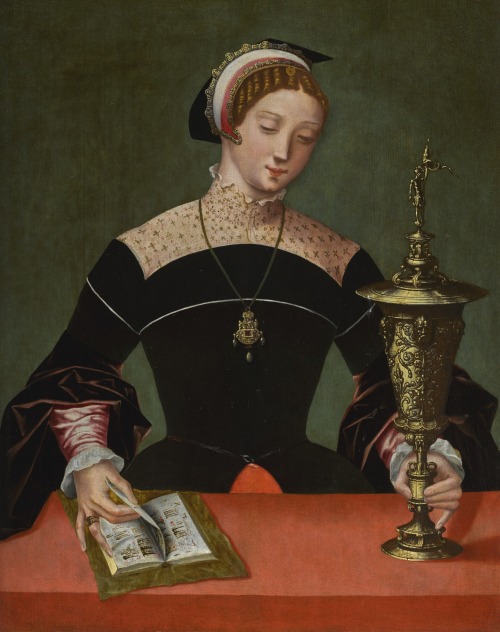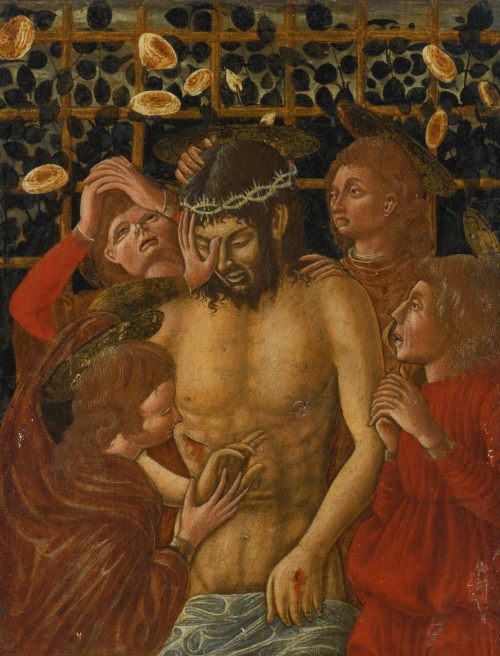#panel painting









HUMANIST PORTRAITURE IN RENAISSANCE ENGLAND
As Lord High Chancellor of England, the humanist scholar and author Sir Thomas More was the highest ranking official of King Henry VIII’s court and one of the wealthiest men in England. In 1527, More commissioned Henry’s Swiss court artist, Hans Holbein the Younger, to paint a group portrait of his extended family. The monumentally-scaled picture, depicting 12, highly-individualized figures in a unified spatial setting, executed in deep, jewel-like colors, set a new standards of invention, complexity and quality hitherto unparalled in English panel painting.
Holbein placed More at the center of the composition. His father, the judge Sir John More, is seated to More’s right and his only son, John, stands to his left. Just beyond the family’s patrinlineal core, is Holbein depicts More’s daughters: Elizabeth Daunce attends to Sir John, while Cecily Heron and Margaret Roper are seated at right. More’s second wife, Lady Alice More, is seated at the far right. Her daughter from her first marriage, Margaret Giggs, stands at the far left. Anne Cresacre, of Sir Thomas and future wife of John, stands behind the Sir John. Also included in the portrait are the household ‘fool,“ Henry Patenson, in orange, and More’s clerk John Harris. All figures are identified by Latin inscriptions.
More’s wife and children all hold books. Some are shown reading, while others pause to reflect with their books either open or mark their place with a finger. The clerk, entering from the right, carries a scrolled document, no doubt intended for Sir Thomas. More books and musical instruments are displayed on a shelf and a large pendulum clock hangs on the rear wall. As he would later do in The Ambassadors, Holbein conspicuously represents these objects to emphasize the literate and learned humanist culture of More’s household. An advocate of the education of women, More educated his wife, daughters, and son in the same liberal arts cirriculum. The panel’s latin inscriptions would have posed problems for no members of the family. Margaret Roper’s mastery as a translator of Greek and Latin was widely acknowledged by More’s humanist peers, including Erasmus.
The deeply-pious More had briefly entered a Carthusian monastery prior to embarking on his political career and his profound Christian belief influenced his theories of humanist education. Margaret is therefore seen reading Seneca’s Œdipus, while Elizabeth carries his Epistolae under her arm. These texts, along with The Consolation of Philosophy by Boethius, seen on a table, represent ancient Stoic philosophy held to be compatible with Christian values. Further indications of the family’s Christian piety include the crucifix worn by Patenson, the rosary worn by Margaret, and the red cross suspended from Elizabeth’s choker. Flowers associated with the Virgin Mary – lilies, carnations, columbine, iris and peony – are displayed in vases around the room.

Painting served an important purpose in More’s learned circle. In 1517, his friends and collaborators Erasmus and the scholar-editor Pieter Gillis (one of the dialogic participants in More’s Utopia), commissioned Quentin Matsys portraits of themselves, showing them at work in their studies, as gifts for More as tokens of their intense intellectual bond.
More’s resistance to Henry VIII’s ecclesiastical policies led to his execution in 1536. His family portrait survived, with several later additions and alterations, until it was destroyed in a fire in 1752. Today, it is known through two 16th-century copies and Holbein’s exquisite preparatory drawings.
Hans Holbein the Younger, Sir Thomas More, c. 1527, Windsor Castle, Royal Collection; Hans Holbein the Younger, Study for the More Family Portrait, 1527, Basel, Kunstmuseum; after Hans Holbein the Younger, Margaret More Roper, 16th c, Knole, National Trust; after Hans Holbein the Younger, Lady Alice More, 16th c., Private Collection; Hans Holbein the Younger, Elizabeth More Daunce, c. 1527, Windsor Castle, Royal Collection; Hans Holbein the Younger, Anne Cresacre, c. 1527, Windsor Castle, Royal Collection; Hans Holbein the Younger, Margaret Giggs Clement, c. 1527, Windsor Castle, Royal Collection; Hans Holbein the Younger, John More, c. 1527, Windsor Castle, Royal Collection; Rowland Lockey after Hans Holbein the Younger, More Family Portrait, 1592, Nostell Priory, National Trust; Hans Holbein the Younger, Sir John More, c. 1527, Windsor Castle, Royal Collection; Hans Holbein the Younger, Cecily More Heron, c. 1527, Windsor Castle, Royal Collection; Quentin Matsys, Erasmus of Rotterdam, 1517, London, Royal Collection Trust; Quentin Matsys, Petrus Egidius, 1517, Antwerp, Koninklijk Museum voor Schone Kunsten Antwerpen.



